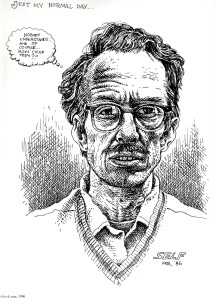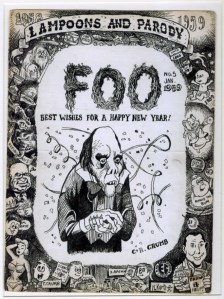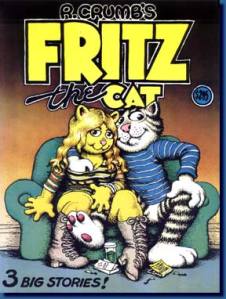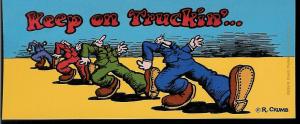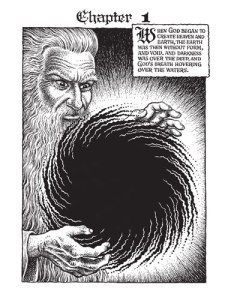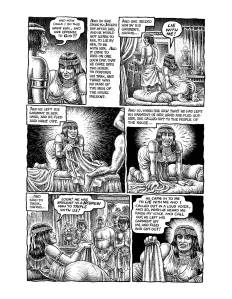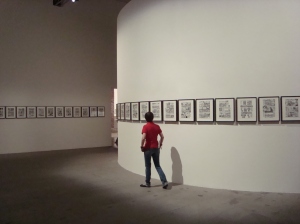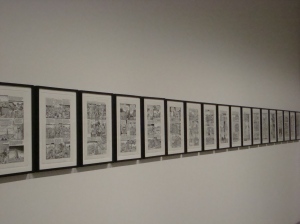Textual Devotion or Sacred Uncensored. The Book of Genesis by Robert Crumb.
Robert Crumb is one of the world most known comics artist and cartoonist. He was born in 1943 in Philadelphia, USA. In his childhood the Crumbs moved a lot, so did he having become an adult. Within the US Robert Crumb changed home from Cleveland to San Francisco, and then to California. During these years (1960s – 1980s) he took the path from greeting cards illustrator to psychedelic cartoons artist. And finally having become disgusted by America at the end of 1980s he, his wife Aline and daughter Sophie left to South of France where they still live.
In his early years Robert Crumb’s biggest influence was his brother Charles. The latter loved comics and it is his merit to introduce Robert to this particular art genre. Cherishing funny animal comics in general and the Walt Disney brand with a special passion,
Charles obtained his siblings to produce their own “home-made comics” as part of the “Animal Town Comics Club”. By the time Robert was 15, the Crumb brothers self-published some of their comics under the umbrella title Foo. It was a three-issue comic book that had some success within a network of fanzine enthusiasts. R. Crumb gained notoriety for characters like Fritz the Cat, a sexually adventurous huckster, and Mr. Natural, a bearded, sybaritic mystic, but it happened later in 1960s. Crumb also became known for his autobiographical comics that dealt with his anxieties and unorthodox sexual fantasies. By the mid-1970s, Crumb was not only a legend in underground comics but had found mainstream renown when his one-page comic “Keep on Truckin” was used as a slogan for 1970s hippie optimism.
Having become famous for cartoons and comics, Robert Crumb and his wife Aline live closed life, their house can hardly be found, and they are surprisingly distrustful for advertisements, media, e-mail and the Internet.
In 2004 Robert Crumb started to work on The Book of Genesis. It was a commercial project but soon Crumb regretted it. It was an enormous work to draw such a Book. It took nearly five years to complete. Having been published in 2009, The Book of Genesis has become the most ambitious work of his to date.
When started working, Crumb was too concerned about the details. As for comics it is usually totally meaningless because the reader does not want all the details, they interfere with the flow of the reading process. “I just can’t help myself—obsessive-compulsive disorder”, – Crumb commented.
The Book of Genesis illustrated by Robert Crumb consists of all 50 chapters on 207 pages of black-and-white drawings. Each word of the biblical text is incorporated. He also left the story stand without interference: all its sex, violence, and Edenic nudity remain uncensored. In the interview to the Paris Review Crumb said that he really tried to stay respectful. But, of course, he understood that ingenuous drawing of nudity, violence, and
sex in a book of sacred text is out of the question. But in the artistic point of view it is of a great importance that he followed his statement of leaving every word of the original text unchanged and illustrated every scene the text tells about.
It goes without saying that before starting to work on such a project, Crumb had had to make a serious research for Genesis. And this challenge was one more primary issue for him. “You have to go way back, to the beginning of Mesopotamian civilization, because the stories of Abraham and all that—that’s like 2000 b.c. It’s hard to find Mesopotamian visual imagery that goes that far back. How did people dress? Did they have doors? Did they have a door on hinges, or what? The Bible says, Lot closed the door and wouldn’t let the men come in, but what’s the door made of?”
At the 55th Venice Biennale The Book of Genesis was chosen by curator Massimilliano Gioni as a part of the main project. It was shown in Arsenale in a white space, each sheet of paper was framed in black correlating with the pages in black and white. The Book of Genesis was quite magnetic, a lot of people were standing exploring each of its page from the very beginning till the end.
The Book of Genesis illustrated by Robert Crumb is a bracingly vivid illumination of one of the world’s best known stories in which the sacred is seen through routine glasses, through the base and lurid lens of the human.
Nastasia Rozhkova
(1) http://ineedartandcoffee.blogspot.ru/2011/05/robert-crumb.html
(2) http://www.comicartcommunity.com/gallery/details.php?image_id=26064
(3) http://indiacomic.blogspot.ru/2012_02_01_archive.html
(4) http://pmpaspeakingofprecision.com/tag/keep-on-truckin/
(5) http://www.theguardian.com/books/gallery/2009/oct/23/robert-crumb-art
(6) http://arthistory.about.com/od/from_exhibitions/ig/r_crumb_genesis/crumb_book_04.htm
